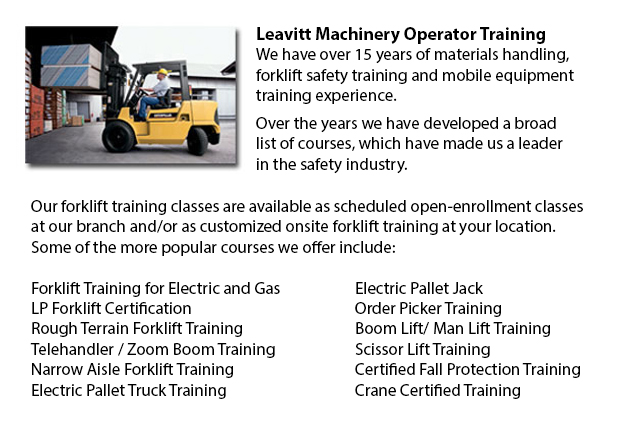
Toronto Forklift Training Schools - What Our Forklift Training Prgrams Could Offer Your Company
Are you searching for a job as a driver of a forklift? Our regulatory-compliant mobile equipment operator training provides instruction in types of lift trucks, pre-shift inspection, fuel types and dealing with fuels, and safe use of a forklift. Practical, hands-on training assists participants in obtaining basic operational skills. Program content includes current rules governing the use of lift trucks. Our proven forklift Schools are designed to provide training on these kinds of trucks: powered pallet truck, narrow isle forklift and counterbalanced forklift.
Do not lower or raise the fork while the lift truck is moving. A load must not extend higher than the backrest due to the danger of the load sliding back toward the operator. Inspect for overhead obstructions and make sure there is enough clearance prior to raising a load. Stay away from overhead power lines. Once the load is lifted straight up, tilt it slightly back.
The lift truck is less stable if a load is in a raised position. Make sure that no one ever walks beneath the elevated fork. The operator should never leave the forklift when the load is lifted.
The forks must be level when handling pallets, and high enough to extend all the way into and under the load. The width of the forks must provide even distribution of weight.
Before loading or unloading the truck, set the brakes and chock the wheels. Floors have to be strong enough to support the weight of the load and the forklift combined. Fixed jacks could be installed to support a semi-trailer which is not attached to a tractor. The entrance door height should clear the forklift height by a minimum of 5 cm. Edges of rail cars, ramps and docks must be marked and avoid them.
-
Toronto Wheel Loader Training
Toronto Wheel Loader Training - Normally, the different kinds of heavy equipment training are classed into 2 categories of machinery: those that have rubber tires and tracked vehicles. Tracked vehicles consist of items like for example excavators, cr... More -
Toronto Heavy Equipment Operator Training
Toronto Heavy Equipment Operator Training - Heavy equipment operator training facilities that provide good standards in the business, providing field performance tasks and added machinery training are really sought after training features. Students a... More -
Toronto Manlift Operator Certification
Toronto Manlift Operator Certification - We provide an aerial lift and scissor platform certification and training to empower the trainee with the general understanding and knowledge of the safe and efficient use of "Power Operated Mobile Work Platfo... More -
Toronto Aerial Boom Lift Ticket
Toronto Aerial Boom Lift Ticket - Aerial lifts can be utilized to accomplish a lot of unique duties done in hard to reach aerial spaces. Some of the odd jobs associated with this type of jack include performing regular preservation on structures with... More -
Toronto Heavy Equipment License
Toronto Heavy Equipment License - Obtaining a heavy equipment license is mandatory in order to operate these big industrial machinery. Certification could be acquired through a vocational school or private training. The license would enable the drive... More -
Skid Steer Loader Training in Toronto
A skid-steer loader is an engine powered equipment which consists of a small and rigid frame. It is outfitted together with lift arms that are utilized to connect to a large variety of labor saving tools and attachments. Typically, skid-steer loaders... More -
Toronto Aerial Lift Certification
Toronto Aerial Lift Certification - Aerial Lift Certification is for individuals who requires an in-depth understanding of aerial lift safety. Inspectors and operators, supervisors, maintenance workers and construction craftsmen should perform a cert... More -
Toronto Boom Lift Training
Toronto Boom Lift Training - Elevated work platforms, also called aerial platforms, allow workers to carry out tasks at heights which would otherwise be not reachable. There are different kinds of lifts intended for various site conditions and applic... More

Forklift Certification Toronto
TOLL FREE: 1-888-254-6157
Toronto, Ontario
forkliftcertificationtoronto.com
Email Us
About Us


